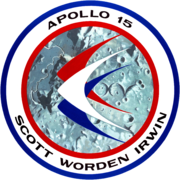Apollo 15

Jim Irwin with the Lunar Roving Vehicle on the first lunar surface EVA of Apollo 15
|
|
| Mission type | Manned lunar landing |
|---|---|
| Operator | NASA |
| COSPAR ID |
|
| SATCAT no. |
|
| Mission duration | 12 days, 7 hours, 11 minutes, 53 seconds |
| Spacecraft properties | |
| Spacecraft |
|
| Manufacturer |
|
| Launch mass | 48,599 kilograms (107,142 lb) |
| Landing mass | 5,321 kilograms (11,731 lb) |
| Crew | |
| Crew size | 3 |
| Members | |
| Callsign |
|
| EVAs |
1 in space |
| EVA duration |
39 minutes, 7 seconds |
| Start of mission | |
| Launch date | July 26, 1971, 13:34:00.6 UTC |
| Rocket | Saturn V SA-510 |
| Launch site | Kennedy LC-39A |
| End of mission | |
| Recovered by | USS Okinawa |
| Landing date | August 7, 1971, 20:45:53 UTC |
| Landing site | North Pacific Ocean 26°7′N 158°8′W / 26.117°N 158.133°W |
| Orbital parameters | |
| Reference system | Selenocentric |
| Periselene | 101.5 kilometers (54.8 nmi) |
| Aposelene | 120.8 kilometers (65.2 nmi) |
| Inclination | 23 degrees |
| Epoch | July 30, 1971 |
| Lunar orbiter | |
| Spacecraft component | Command/Service Module |
| Orbital insertion | July 29, 1971, 20:05:46 UTC |
| Departed orbit | August 4, 1971, 21:22:45 UTC |
| Orbits | 74 |
| Lunar lander | |
| Spacecraft component | Lunar Module |
| Landing date | July 30, 1971, 22:16:29 UTC |
| Return launch | August 2, 1971, 17:11:23 UTC |
| Landing site |
Hadley–Apennine 26°07′56″N 3°38′02″E / 26.13222°N 3.63386°E |
| Sample mass | 77 kilograms (170 lb) |
| Surface EVAs | 4 (including standup) |
| EVA duration |
|
| Lunar rover | |
| Distance covered | 27.9 kilometers (17.3 mi) |
| Docking with LM | |
| Docking date | July 26, 1971, 17:07:49 UTC |
| Undocking date | July 30, 1971, 18:13:16 UTC |
| Docking with LM Ascent Stage | |
| Docking date | August 2, 1971, 19:10:25 UTC |
| Undocking date | August 3, 1971, 01:04:01 UTC |
| Payload | |
| Mass |
|
 Left to right: Scott, Worden, Irwin |
|
1 in space
39 minutes, 7 seconds
Apollo 15 was the ninth manned mission in the United States' Apollo program, the fourth to land on the Moon, and the eighth successful manned mission. It was the first of what were termed "J missions", long stays on the Moon, with a greater focus on science than had been possible on previous missions. It was also the first mission on which the Lunar Roving Vehicle was used.
The mission began on July 26, 1971, and ended on August 7. At the time, NASA called it the most successful manned flight ever achieved.
Commander David Scott and Lunar Module Pilot James Irwin spent three days on the Moon, including 18½ hours outside the spacecraft on lunar extra-vehicular activity (EVA). The mission landed near Hadley rille, in an area of the Mare Imbrium called Palus Putredinus (Marsh of Decay). The crew explored the area using the first lunar rover, which allowed them to travel much farther from the Lunar Module (LM) than had been possible on missions without the rover. They collected 77 kilograms (170 lb) of lunar surface material. At the same time, Command Module Pilot Alfred Worden orbited the Moon, using a Scientific Instrument Module (SIM) in the Service Module (SM) to study the lunar surface and environment in great detail with a panoramic camera, a gamma-ray spectrometer, a mapping camera, a laser altimeter, a mass spectrometer, and a lunar sub-satellite deployed at the end of Apollo 15's stay in lunar orbit (an Apollo program first).
...
Wikipedia

